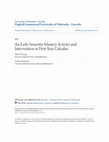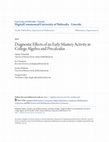Papers by Nathan Wakefield
Investigations in Mathematics Learning, 2022
To cite this article: Miller, N. & Wakefield, N. (2014). A mentoring program for inquiry-based te... more To cite this article: Miller, N. & Wakefield, N. (2014). A mentoring program for inquiry-based teaching in a

Let (gi)i ≥1 be a sequence of Chebyshev polynomials, each with degree at least two, and define (f... more Let (gi)i ≥1 be a sequence of Chebyshev polynomials, each with degree at least two, and define (fi) i ≥1 by the following recursion: f1 = g1, fn = gn ∘ fn–1, for n ≥ 2. Choose α ∈ [special characters omitted] such that {[special characters omitted](α) : n ≥ 1} is an infinite set. The main result is as follows: Let γ ∈ {0, ±1}, if f n(α) = [special characters omitted] is written in lowest terms, then for all but finitely many n \u3e 0, the numerator, An, has a primitive divisor; that is, there is a prime p which divides An but does not divide Ai for any i \u3c n. In addition to the main result, several of the tools developed to prove the main result may be of interest. A key component of the main result was the development of a generalization of canonical height. Namely: If [f] is a set of rational maps, all commuting with a common function f, and f = [special characters omitted] is a generalized iteration of rational maps formed by f n(x) = gn( fn–1(x)) with gi coming from [f], then there is a unique canonical height funtion ĥf : K → [special characters omitted] which is identical to the canonical height function associated to f. Another key component of the main result was proving that under certain circumstances, being acted upon by a Chebyshev polynomial does not lead to significant differences between the size of the numerator and denominator of the result. Specifically, let γ ∈ {0, ±1, ±2} be fixed, and gi be a sequence of Chebyshev polynomials. Let f given by the following recurrence f 1(z) = g1(z), and fi = gi( fi–1(z)) for i ≥ 2. Pick any α ∈ [special characters omitted] with |α + γ| \u3c 2, such that α + γ is not pre-periodic for one hence any Chebyshev polynomial. Write f n(α + γ) − γ = [special characters omitted] in lowest terms. Then limn→∞ logAn logBn =1. Finally, some areas of future research are discussed
We define a new method of measuring the rate of divergence for an increasing positive sequence of... more We define a new method of measuring the rate of divergence for an increasing positive sequence of integers. We introduce the growth function for such a sequence and its associated growth limit. We use these tools to study the divergence rate for the natural numbers, polynomial and exponential-type sequences, and the prime numbers. We conclude with a number of open questions concerning general properties and characterizations of growth functions and the set of possible growth limits.
In recent years, providing teaching professional development for graduate teaching assistants has... more In recent years, providing teaching professional development for graduate teaching assistants has become more common in mathematics departments in the US. Following this trend, mathematics education researchers have begun to conduct studies on professional development programs and on graduate students as novice teachers. The purpose of this literature review is to examine the current status of research in this field and make recommendations for future research on graduate teaching assistants and professional development. In examining the literature, we utilize an existing framework for collegiate teaching practices and focus on studies that attended to growth. As a result of this literature review, we recommend that researchers begin developing models or theories for how and why graduate students grow as teachers.
At the University of Nebraska-Lincoln, nearly 1000 students sign up for one of College Algebra, o... more At the University of Nebraska-Lincoln, nearly 1000 students sign up for one of College Algebra, or College Algebra and Trigonometry every fall. Of these students, more than 75% are first time freshman. Finding ways to motivate and encourage these students together with early identification strategy for struggling students is critical to success not just in the math course, but also in a student's university career. This presentation will discuss the design and outcomes an early intervention mastery activity with the broad goals of helping students recall previously learned mathematics, and identifying students who are at risk for failure, all within two weeks of the start of the semester.
International Journal of Education in Mathematics, Science and Technology, 2014
This paper describes a mentoring program designed to prepare novice instructors to teach a colleg... more This paper describes a mentoring program designed to prepare novice instructors to teach a college geometry class using inquiry-based methods. The mentoring program was used in a medium-sized public university with approximately 12,000 undergraduate students and 1,500 graduate students. The authors worked together to implement a mentoring program for the first time. One author was an associate professor and experienced using inquiry-based learning. The other author was a graduate student in mathematics education. During the course of the year the graduate student first observed and then taught a college level inquiry-based geometry course for pre-service teachers. This article describes the details of this mentoring program and our reflections on how the program went.

Based upon Active Calculus by Matthew Boelkins Several fundamental ideas in calculus are more tha... more Based upon Active Calculus by Matthew Boelkins Several fundamental ideas in calculus are more than 2000 years old. As a formal subdiscipline of mathematics, calculus was first introduced and developed in the late 1600s, with key independent contributions from Sir Isaac Newton and Gottfried Wilhelm Leibniz. Mathematicians agree that the subject has been understood rigorously since the work of Augustin Louis Cauchy and Karl Weierstrass in the mid 1800s when the field of modern analysis was developed, in part to make sense of the infinitely small quantities on which calculus rests. As a body of knowledge, calculus has been completely understood for at least 150 years. The discipline is one of our great human intellectual achievements: among many spectacular ideas, calculus models how objects fall under the forces of gravity and wind resistance, explains how to compute areas and volumes of interesting shapes, enables us to work rigorously with infinitely small and infinitely large quant...

Success in first-year mathematics courses is essential for students to pursue STEM careers, inclu... more Success in first-year mathematics courses is essential for students to pursue STEM careers, including teaching careers. We investigate a mastery activity given during the first two weeks of a first-year calculus course at the research site. Previous work showed a model using this activity in College Algebra, together with ACT and high school rank, was predictive of student success in precalculus. Here we do a similar analysis for such an activity in calculus, including an intervention for students who do not complete the activity. We also investigate the intervention’s effectiveness. These results show that the early mastery activity, especially when combined with other indicators of mathematics readiness, is useful in identifying students at risk of failing calculus. Moreover, descriptive statistics suggest that students who participate in the intervention are more successful than expected, based on their academic backgrounds and other college grades.

The purpose of this study was to investigate implementation of an early intervention mastery acti... more The purpose of this study was to investigate implementation of an early intervention mastery activity during the first two weeks of college algebra and precalculus courses at a large U.S. public university. Statistical modeling of (N = 935) students’ performance in the courses, including a logistic regression model of pass/fail course achievement with students’ high school rank, ACT Mathematics scores, and performance on the intervention as explanatory variables, suggested significant independent differences in course performance across performance levels on the early mastery activity. An evaluation of diagnostic validity for the model yielded a 19% false negative rate (predicted to fail the course, but passed) and a 7% false positive rate (students predicted to pass the course, but failed), suggesting the early mastery activity, when combined with admissions indicators of mathematics readiness, may be useful in better identifying students at risk of failing their first university m...
Association for Women in Mathematics Series
Exemplary models to inform novice instruction and the development of graduate teaching assistants... more Exemplary models to inform novice instruction and the development of graduate teaching assistants (TAs) exist. What is missing from the literature is the process of how graduate students in model professional development programs make sense of and enact the experiences offered. A first step to understanding TAs' learning to teach is to characterize how and whether they link observations of student work to hypotheses about student thinking and then connect those hypotheses to future teaching actions. A reason to be interested in these connections is that their strength and coherence digitalcommons.unl.edu











Uploads
Papers by Nathan Wakefield